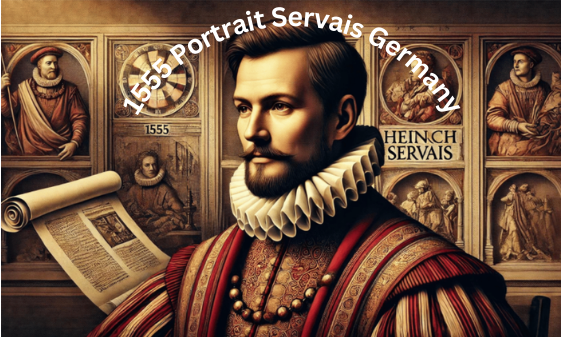Introduction
1555 Portrait Servais Germany” is a fine piece of the renaissance art that depicts the innovations as well as the cultural aspects of the period. Thus this work of art is not just a portrayal of an individual but it symbolizes and depicts the social and artistic changes which were happening in Germany in the 16th century. In this article, the author traces the historical background and its formation, meaning and significance as well as its impact on art.
Historical Context of the 1555 Portrait Servais Germany
The Renaissance Revolution
The painting was create when a new era was dawn in Europe with new consciousness in terms of art, science, culture that is call the Renaissance. Humanism characterised this period as schools of learning placed importance in the individual as well as aiming to know more of the ancient cultures. This painting of ‘1555 Portrait Servais Germany’ represents the change of paradigm of this period that was mark by relevant features of realism and individuality.
Political and Religious Turmoil
However, at the same time that the Goethe generation in Germany was enjoying what has been called a cultural renaissance. Germany was being buffeted by great political and religious changes. At the beginning of the sixteenth century Martin Luther had begun the Protestant Reformation, which was altering the structure of Christianity in Europe. It also created civil disobedience to the Catholic Church’s authority and raised a number of societal issues. These dynamics are reflected in the portrait as the subject represents the person’s individuality and at the same time is shaped by historicity.
Also read: Flixfy.lat
Analysis of the 1555 Portrait Servais Germany Composition
Central Placement and Dramatic Presence
Thus, the arrangement of the picture “1555 Portrait Servais Germany” is literally construct in such a manner that the viewer would focus on the main subject, which is Servais. The subject is thereby placed right at mid of the picture and commanding attention for grandeur. This technique makes sure that the viewer’s gaze is immediately attracted towards the subject and the relation felt is personal.
Use of Light and Shadow
The light and dark techniques are used by the artist to model the figure and it looks very much like a casting. The shift from light to shade and vice versa. As well as the use of numerous hatching patterns enables the artist to bring out realism even in the details of the subject’s face. Characteristic to the Renaissance period, this technique is called chiaroscuro and is evident in this portrait.
Attention to Detail
The intricate details of the clothing and accessories in the portrait are render with exceptional skill. Each fold and texture of the fabric is meticulously paint, showcasing the artist’s technical prowess. These details not only demonstrate the subject’s wealth and status but also provide insight into the fashion and material culture of the period.
Symbolism and Meaning in the 1555 Portrait Servais Germany
The Language of Clothing and Accessories
The attire and adornments in the “1555 Portrait Servais Germany” are rich in symbolic meaning. The subject’s clothing, with its fine fabrics and elaborate embroidery, signifies wealth and social standing. Each accessory, whether it be a book, a piece of jewelry, or an object related to trade, carries its own significance, offering clues about the subject’s identity and profession.
Color Symbolism
The colors used in the portrait also convey specific meanings. Warm colors, such as reds and golds, suggest vitality and power, while cooler tones, like blues and greens, evoke calmness and introspection. The careful selection of colors adds another layer of depth to the portrait, enriching the viewer’s understanding of the subject.
Personal and Cultural Narratives
Beyond its visual appeal, the portrait serves as a narrative device, intertwining personal history with broader cultural themes. The subject’s pose and expression offer a glimpse into their personality and inner life. While the surrounding elements reflect the cultural and historical context of the time. This duality makes the portrait a powerful storytelling tool.
The Artist Behind the 1555 Portrait Servais Germany
A Master of His Craft
The artist behind this masterpiece, often identified as Servais Germany, was a prominent figure in the 16th century art world. His works are characterized by a blend of realism and drama, capturing the essence of his subjects with remarkable precision. While details of his life remain somewhat obscure, his contributions to Renaissance art are undeniable.

Aesthetic and Realistic Approach
Servais Germany’s approach to portraiture was deeply influence by the aesthetic principles of the Renaissance. He skillfully balanced realism with artistic expression, creating portraits that were both lifelike and evocative. His attention to detail and ability to convey emotion through his work set him apart as a master of his craft.
Legacy and Influence
The techniques and stylistic choices of Servais Germany had a lasting impact on the art world. His work influenced subsequent generations of artists. Who drew inspiration from his ability to capture the human experience in their portraits. The “1555 Portrait Servais Germany” stands as a testament to his enduring legacy.
Impact and Legacy of the 1555 Portrait Servais Germany
Historical Significance
The “1555 Portrait Servais Germany” holds a significant place in art history, not only for its aesthetic qualities. But also for its cultural and historical importance. The portrait offers valuable insights into the social and political landscape of 16th century Germany, serving as a visual record of the period.
Influence on Future Art
The techniques and themes explored in this portrait continued to resonate with artists in the centuries that followed. The emphasis on realism, individualism, and symbolic depth became defining characteristics of Western portraiture. The legacy of the “1555 Portrait Servais Germany” can be seen in the works of artists. Who sought to capture the complexity of the human experience in their own portraits.
Preservation and Continuation
Efforts to preserve the “1555 Portrait Servais Germany” have ensured that this masterpiece remains accessible to future generations. Through careful conservation and documentation, the portrait continues to be studied and appreciated by art historians, scholars, and enthusiasts alike. Its ongoing relevance underscores the timeless appeal of Renaissance art.
Collecting and Preserving Historical Art for Future Generations
The Role of Collectors
Art collectors play a crucial role in preserving historical artworks like the “1555 Portrait Servais Germany.” By acquiring and maintaining these pieces, collectors ensure they remain accessible for future generations to study and appreciate. Collecting historical art isn’t just about possession; it is about preserving cultural heritage and supporting the continuation of artistic traditions.
Modern Preservation Techniques
Modern preservation techniques have revolutionized art conservation. Controlled climate storage, careful handling, and specialized cleaning methods help maintain the integrity of the artwork. Digital technology, such as high-resolution imaging and 3D modeling, allows detailed study and analysis without risking damage to the original piece. These technologies enable the creation of detailed records and replicas, ensuring. That the information and aesthetics of the artwork are preserve even if the original suffers damage.
Educational and Exhibition Programs
Exhibitions and educational programs play a vital role in fostering an appreciation for historical art. Museums and galleries around the world showcase works like the “1555 Portrait Servais Germany” offering visitors the opportunity to engage with these masterpieces firsthand. Educational programs, including lectures, workshops, and interactive exhibits, deepen the public’s understanding of the historical and cultural significance of these artworks.
Conclusion
The “1555 Portrait Servais Germany” stands as a remarkable testament to Renaissance art and its enduring legacy. From its rich historical context to the meticulous techniques and symbolic depth. This portrait offers a profound insight into the cultural and artistic practices of the 16th century. The efforts of collectors and modern preservation techniques ensure that this masterpiece remains an accessible and valuable part of our cultural heritage, continuing to inspire and educate future generations.
This portrait is more than a mere depiction of an individual; it is a window into a pivotal moment in history. Through its intricate details, symbolic elements, and masterful composition. The “1555 Portrait Servais Germany” captures the essence of the Renaissance and its lasting impact on the world of art. Its timeless beauty continues to captivate audiences, reminding us of the enduring power of art to connect us with our past and inspire our future.
